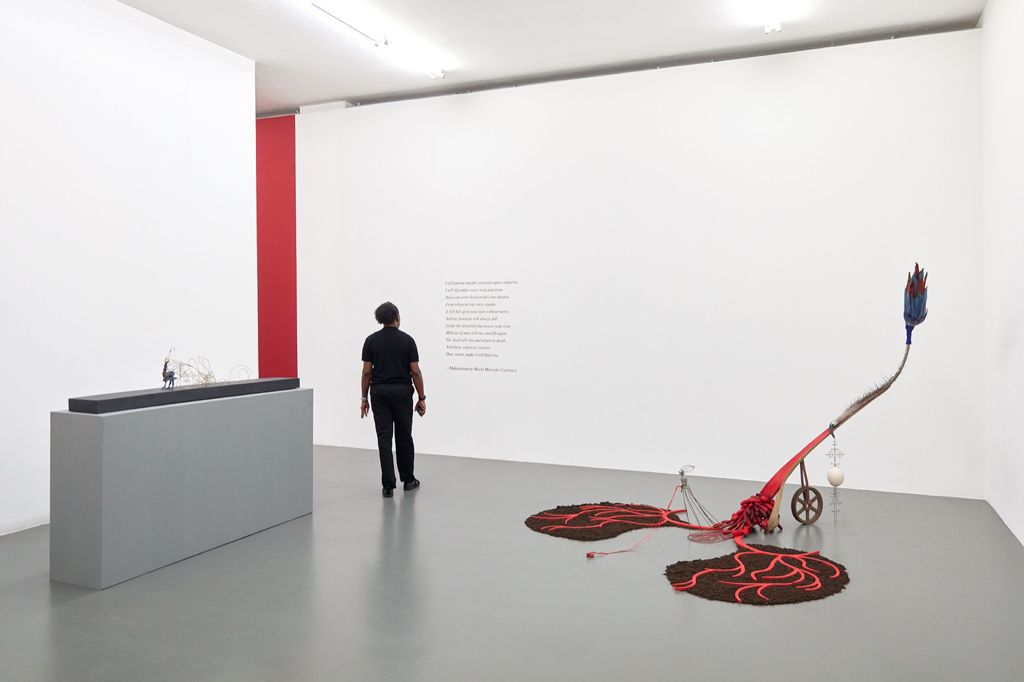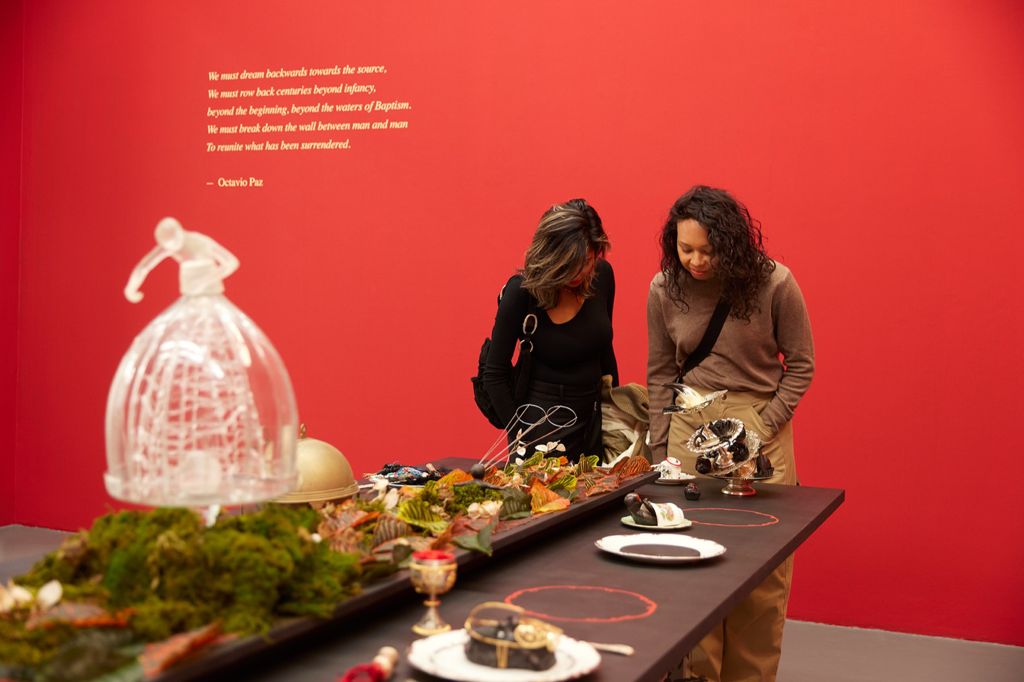
An art enthusiast takes in a piece in Jasmine Thomas-Girvan's Turntable Series, during her solo exhibition at at Kunstinstituut Melly in The Netherlands, October 2021. Photo by Aad Hoogendoorn, courtesy Kunstinstituut Melly, used with permission.
The lush, tree-filled backyard of Jamacian-born, Trinidad-based artist Jasmine Thomas-Girvan‘s urban childhood home was to have an impact on her creative process that she could never have imagined when she first received her Bachelor of Fine Arts degree from the groundbreaking Parsons School of Design in the 1980s. Over the course of her long career, her work has expanded from amazingly intricate jewellery pieces to large-scale installations that merge sculpture with elements of multimedia.
In her latest solo exhibition at Kunstinstituut Melly in The Netherlands, “Bathed in Sacred Fire,” Thomas-Girvan takes those natural elements that made such an impression on her in her youth and uses them to launch a discussion about Caribbean identity. Her art deftly strips bare the region's traumatic colonial past, presenting it in such hauntingly beautiful and empowering ways that you dare not look away, lest you miss a precious and powerful detail.

An art enthusiast takes a photo of Jasmine Thomas-Girvan's “Real Princess”, which features a cedar chest combined with plexiglass, mirror, antique crystal, pig bones, coconut shells, paper and lace. Photo by Aad Hoogendoorn, courtesy Kunstinstituut Melly, used with permission.
Neither is her commentary monolithic. Instead, it oozes the kind of magical realism that allows us to connect with experiences of indigenous Africa, with the horrors of the Middle Passage and slavery, all the way to postcolonial sociopolitical issues and race relations at play in the Americas. None of it feels preachy; instead, each piece portrays tangibility and truth in a very personal way. It's a raw, tender examination of ancestry with a distinctly contemporary artistic approach.
Thomas-Girvan's love of literature adds further context to the exhibit, as quotes by poets like Olive Senior and Octavio Paz hover on the wall space behind certain pieces. Via email, I interviewed the artist about her vision for this exhibit and what she wants people to take away from it.

Artist Jasmine Thomas-Girvan (in black with headtie) in conversation with Annalee Davis (in red) and Holly Bynoe (far right) of the contemporary art collective Sour Grass, which curated the exhibition. Photo by Aad Hoogendoorn, courtesy Kunstinstituut Melly, used with permission.
Janine Mendes-Franco (JMF): One of the things I love most about your art is that it’s fearless. You’re not afraid to experiment and take risks, whether it be with materials, subject matter, or even how you combine them to make a statement. Where does that come from and how does it inform your art—especially when you’re trying to say something difficult?
Jasmine Thomas-Girvan (JTG): James Hillman said, ‘The great task of any culture is to keep the invisibles attached.’ Trying to locate the ‘invisibles’ excite me! There are so many questions for which I am seeking understanding and so this is my work. I want to rigorously delve into this challenge. I am interested in the insidious psychic dissonance of the colonial project and, as a believer in lifelong learning, being satisfied with the status quo for me is to surrender to fear. If you only create from a comfortable familiar place you don’t grow. Without taking risks and pushing boundaries, my art would remain stagnant and my creative spirit would have been wasted on my fears.
This curiosity feeds my experimentation.I feel frustration with the gulf in my knowledge of our heritage. My most recent work considers the indigenous heritage of the wider Caribbean, particularly Taino and African cosmology. This work is a tool for reflection, exhuming the forgotten mysteries of the Indigenous and African presence by creating visual poetry in sculpture that is saturated with metaphors, motifs and materials that celebrate our First Peoples. I purposefully use materials [feathers, shells, stone, gourds, seeds, wood, bones and architectural detritus] that I find in the environment to reinforce my connection to specific geography.

Jasmine Thomas Girvan's ‘Terra Preta,’ which uses an array of materials, including Queen Palm fronds, macaw feathers, bicycle wheels, wood, silk, recycled cast iron, bronze, ribbon and an ostrich egg. Photo by Aad Hoogendoorn, courtesy Kunstinstituut Melly, used with permission.
JMF: You see artistic potential in found or natural elements, combining hard and soft materials in a breathtaking way and skilfully making seemingly dissonant materials bend to your will. Tell us about the process of working with such a disparate range of elements.
JTG: I often feel I am bending to the will of the materials, as often the materials present themselves in alignment with my practice. Over time, I have learnt to be patient and to allow works to evolve organically. This comes from a deep respect for materials, process and the acceptance of failure as an integral part of this process. The use of seemingly disparate materials is faithful to our hybrid stories. I believe the ‘dissonant’ material choices help magnify these complex narratives. Audre Lorde‘s words, “[…] for the master's tools will never dismantle the master's house,” come to mind. I am always looking for alternative implements to communicate things which are idiosyncratic, ephemeral, enigmatic and incomprehensible to ‘rectify the wilful blindness of colonialism.’ I seek appropriate materials to resolve my investigations. […] I have learnt to respect the integrity of disparate elements and to trust their innate offerings. […] Our history is dissonant, so the redeeming/redreaming of it should reflect this tension—a tension demanding us to change the context by reshaping the interpretation of historical truths.

Jasmine Thomas-Girvan's ‘Dreaming Backwards’ table, with its glass centrepiece. Photo by Aad Hoogendoorn, courtesy Kunstinstituut Melly, used with permission.
JMF: As a Caribbean person, the subject matter feels familiar to me. How much do regional folklore and oral tradition contribute to this, and what have non-regional audiences been taking away?
JTG: Yes, the work has its taproots in Caribbean history, folklore, spirituality and music. The colonisers tried to annihilate anything that posed a threat to their dominion, ruthlessly eliminating our culture in overt and covert ways. But we not only survived, but thrived. This was possible through remote realms over which they had no control—[traditions and rituals that] help[ed] to preserve our culture. Though the details are specific to the Caribbean, the archetypes are replicated across cultures and geographies, so people identify with the universal themes […] in the pieces. Maybe that is the point: that people will see the similarities, appreciate the differences and emerge with a better understanding of self and humanity. I see the work as a trigger of experience, and my hope is that viewers will be motivated to seek out further information.
JMF: Which is your favourite piece in this exhibit and why?
JTG: I was going say I have no favourites, but on reflection I would have to say the three sculptures: ‘Scanning every horizon,’ ‘The Field Beyond,’ and ‘Inside the Labyrinth-Gyan Chaupar.’ These wax models were very badly damaged in transit to the foundry and seemed beyond redemption! But I could not allow many months of work to be negated by Babylon! I was determined to complete the series. The process by which they came into being gave deeper significance to the title ‘Bathed in Sacred Fire.’ The reimagining, remaking, reconstituting the pieces conjured up Derek Walcott‘s words from Fragments of Epic Memory: ‘Antillean Art is the restoration of our shattered histories, our shards, our vocabulary, our archipelago becoming a synonym for pieces broken off from the original continent.’
The possibility of seeing beyond the immediate catastrophe and bringing all energies to bear on repair and wholeness, literally piecing together the shattered fragments that represent the Epic memory—our heritage, in the present reaching into the past for healing—was profound. As I sat working in the busy foundry workshop in Tiel, the radio was blasting European pop music until suddenly, I was reassured by the mystical, familiar voice of Bob Marley singing, ‘Don’t worry bout a ting […] every lickle ting gonna be alright,’ mysteriously reaching out over the airways, through time and space, connecting past and present, the natural mystic, the balm of ancestral guidance. I will never forget the synchronicity of [that] moment!

Holly Bynoe views Jasmine Thomas-Girvan's ‘Ancestral Anguish.’ Photo by Aad Hoogendoorn, courtesy Kunstinstituut Melly, used with permission.
JMF: Your piece “Ancestral Anguish,” for instance, has beauty and power in pain. In a region that finds it difficult to talk productively and dispassionately about colonialism and its effects, how can we use art and its spaces to begin to have useful discussions that carry through into how we operate in Caribbean societies?
JTG: There are many deeply entrenched attitudes from our colonial past that continue to poison how we view ourselves and our citizenry. ‘Ancestral Anguish’ speaks specifically to the disappearance of young girls in Jamaica. Who is preying on these young ones? Some things have not changed and the trafficking of black bodies continues. We need to not only honestly interrogate these exploitative systems but courageously situate ourselves within it. ‘The Table’ exposes the exploitation of blackbodies in the context of the luxury that it afforded slaveowners. The rise of European economies was only possible because of the vulgar profits derived from Plantation Slavery. As colonial subjects, our tastes and aspirations are still intimately tethered to the habits of the plantation [and] our addiction to a particular lifestyle […] continue to enable those exploitative systems.

Students examine Jasmine Thomas-Girvan's ‘Dreaming Backwards’ table. Photo by Aad Hoogendoorn, courtesy Kunstinstituut Melly, used with permission.
JMF: Your use of glass fascinates me. There’s one photograph of “The Table,” which shows the glass figure bent forward at an angle where her head appears to be cut off—but the head in the centre of “Ancestral Anguish,” directly behind it, dramatically fills this negative space with a rippling red aura. The crystalline nature of the glass offers an almost eternal connection and continuity between the two pieces, yet it is also fragile. Are there parallels here with the bigger discussion of the colonial legacy?
JTG: This is what really charges an Art work—when the viewer animates it with their own eyes, presence and heart tapping into those ‘eternal connections.’ The glass figure is bowed looking inwards, suggesting introspection. Under the skirt is a delicate glass web under which Anansi is sheltering. The glass represents our fragile but formidable selves, where Anansi prevails. What you are describing is the replacement of the individual head with that of our ancestors, a potent magnetic field emanating into infinity. This rippling aura that you describe is for me ‘all the restless wayward spirits of all the aeons’ that Wilson Harris speaks of so eloquently in Palace of the Peacock.
[He says they] ‘are returning to roost in our blood. And we have to start all over again where they began to explore. We’ve got to pick up the seeds again where they left off. […] We’ve got to face it. Or else it will be too late to stop everything and everyone from running away and tumbling down. And then all the kings and all the kings’ men won’t be able to put us together again. This new independence is insubstantial top-soil; the real battle is below.’
JMF: This is not a sugar-coated exhibit, but it does feel hopeful. How do you believe we will overcome?
JTG: The real battle is below and within.






